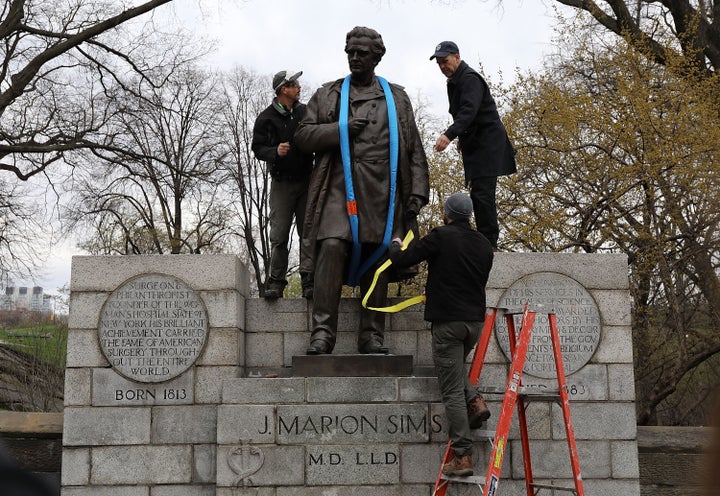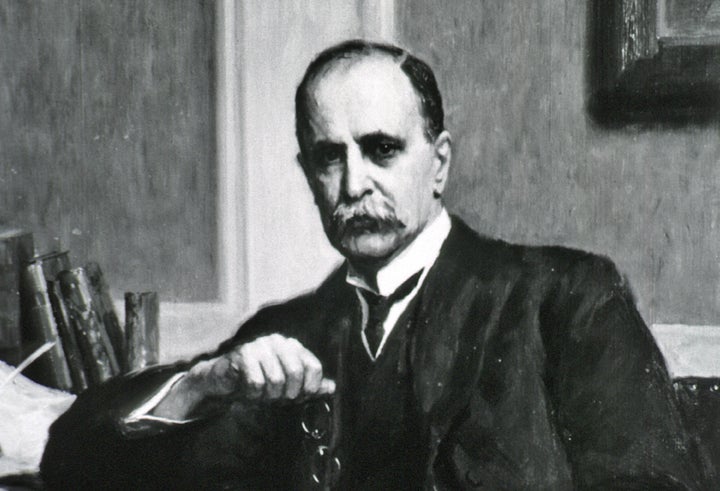U.S. statues of Confederate leaders and Christopher Columbus have been vandalized, beheaded or toppled. In Canada, the statues of racist architects of settler colonialism like John A. Macdonald and Edward Cornwallis have met a similar fate. The message is clear: we must rethink our society’s heroes within the full context of the oppression, exploitation and, at times, murder that helped them achieve prominence.
The same goes for canonized physicians, historically shrouded in a veneer of benevolence for their scientific advances. Some of medicine’s most eminent figures owe their work to systems of racial oppression and discrimination, often at untold cost to Black and Indigenous communities.

Nineteenth-century American surgeon Dr. James Marion Sims, known as the “father of modern gynecology,” has been memorialized in statues, buildings and paintings. In Medical Apartheid, Harriet A. Washington explains how Sims, himself a slave-owner and defender of the slave system, developed surgical techniques after practicing brutal procedures on enslaved Black women and girls without anesthesia or consent. Sims also experimented on Black infants and children. He is credited for knowledge acquired through medical exploitation, yet the names of those who suffered (Anarcha, Betsey, Lucy...) are missing from textbooks.
Sir William Osler, the “father of modern medicine,” is one of Canada’s most well-known medical figures. When I was a student at McGill University, the Faculty of Medicine offered each of us a collection of his works. I was inspired by a quote famously attributed to him: “The good physician treats the disease; the great physician treats the patient who has the disease.” However, none of us were told about Osler’s racist beliefs, or his white nationalist reflections about Canada: “We are bound to make our country a white man’s country.”
“These Canadian physicians continue to be honoured today, monuments to them still standing.”
Another example is Hospital for Sick Children pediatrician and researcher Dr. Frederick Tisdall, who also served as the president of the Canadian Pediatric Society. In the early 1940s, he was involved in a two-year experiment conducted on the Cree community of Norway House, in northern Manitoba. While starvation and malnutrition were rampant (themselves a result of colonial policies), Tisdall and his fellow researchers provided vitamin supplements to some subjects and not to others in order to determine whether physical manifestations of different diseases could be treated with supplementation only. Community members of all ages were studied, but the focus on children in physician-led nutrition studies took on even more disturbing proportions a few years later.

In 1948, Dr. Percy Moore, director of the Canadian government’s Indian Health Service, lent his full support to horrific, large-scale experiments designed by Dr. Lionel Bradley Pett. The goal was to assess the impacts of malnutrition firsthand by initiating a years-long series of experiments on hundreds of starved Indigenous students at six residential schools across the country. A panoply of health-care providers (dentists, doctors, nurses, nutritionists) conducted physical exams, intelligence scoring and blood tests. Similar to the studies in northern Manitoba led by Moore and Tisdall, the solution to the medical problems in the residential school experiments was known at the time: ending imposed malnutrition and starvation.
Decolonizing health care
These Canadian physicians continue to be honoured today, monuments to them still standing. In Montreal alone, a street, a hospital amphitheatre and a medical library bear Osler’s name, while several physical-exam findings and diseases are eponymic terms (Osler’s nodes, Osler-Weber-Rendu disease/syndrome, etc.). Tisdall is celebrated for having co-developed Pablum infant cereal. A hospital in Manitoba is named after Moore.
Acknowledging Tisdall’s destructive legacy, the Hospital for Sick Children recently modified its webpage commemorating him, but such change has been painfully slow in the conservative institution of medicine. Those resistant to change defend that such individuals can’t be judged based on “presentist” arguments — that is, the retroactive application of contemporary values and morality. They prefer to see influential figures of the past as simply “individuals of their age” or a “product of their time.”
“We must question why we are so obsessed with elevating powerful white men like Sims, Osler, Tisdall and Moore in the first place.”
However, that depends on the vantage point we choose to take: Do only the perspectives of the rich and powerful matter? Would the legacy of these “heroes” have been possible without the exploitation and oppression of others? Meanwhile, why aren’t those who fought to end oppression, including in health care, considered to be the moral gauges of their time? For example, why don’t we commemorate firebrand physician-activist Marie Equi, who fought alongside working-class women and against imperialism in the early 1900s? Why don’t we acknowledge how the Black Panthers framed modern notions of health care as a cornerstone of social justice in the 1960s?
Asking these questions demonstrates how those who wield power shape the present and recast the narratives of the past. Moreover, not asking these questions ignores the experiences of those who suffered at the hands of those in power, marginalizes past struggles for health justice, and perpetuates historical racism that has implications to this day.

For example, Évacuations aéromédicales du Québec (ÉVAQ) systematically prevented caregivers from accompanying their children on flying hospital medevac airlifts for decades. During my involvement with the #aHand2Hold campaign to put an end to the practice in 2018, many colleagues observed that the non-accompaniment rule would have ended long ago if it wasn’t Indigenous communities that were disproportionately impacted. The forced separation of hundreds of Indigenous children from their families was normalized through a medical culture that dehumanizes individuals and stigmatizes entire communities. During the campaign, some of us began referring to this as “medical colonialism.”
There is no one individual who is responsible for the dominant medical culture in North America, but we must question why we are so obsessed with elevating powerful white men like Sims, Osler, Tisdall and Moore in the first place. After all, monuments cast shadows.
We must decolonize health care. Monuments to these men should be taken down, but not with the goal of erasing history. On the contrary, the stories of these medical pioneers must be told, capturing the full scope of their actions. We must make certain that every medical student learns about where much of our knowledge comes from, and the active role health-care providers have played in slavery and colonialism.
If we insist on having monuments, let’s build them to honour the memories of the victims and survivors of the medical establishment, reminding us that the injustices of the past should never be repeated.
Samir Shaheen-Hussain’s forthcoming book, Fighting for A Hand to Hold: Confronting Medical Colonialism against Indigenous Children in Canada, will be published by McGill-Queen’s University Press in September 2020. All the author’s book royalties have been directed to designated groups and initiatives in support of Indigenous children, youth and their communities.
Have an opinion you’d like to share on HuffPost Canada? You can find more information here on how to pitch and contact us.
Also on HuffPost: